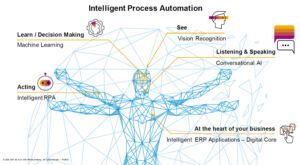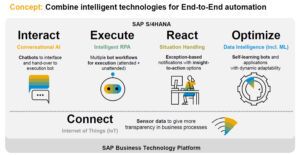Intelligent Technologies as an Integral Part of SAP S/4HANA - An Overview (Part2)

(4 min read)
In the second part of our blog series “Intelligent Enterprise”, we provide an overview of the individual innovative technologies and tools. And we explain how they fit into your SAP S/4HANA business processes.
In our private lives, at home and on the road, we have long been using intelligent technologies built into our everyday objects. The variety of uses is enormous: You operate your car navigation or your TV by voice or are informed about upcoming appointments by digital assistants such as Siri or Alexa. Behind all these smart helpers are intelligent technologies.
But if you look at your day-to-day business activities, especially how you operate your inventory management system and communicate with the ERP system, you’ll notice a big disconnect. In doing so, you could integrate the intelligence you experience in everyday life into your ERP system and apply the user experience from your private life to your everyday business. We will show you how to do this using SAP S/4HANA as an example.
See, Listen, Speak, Think and Act in SAP S/4HANA
Modern ERP systems basically have the capabilities of a human being, such as seeing, listening, speaking, thinking and acting – this is shown in the following figure. Seeing is enabled by video cameras and image recognition. With the help of a microphone and a speaker, the system is able to listen and speak, which is not even new. By thinking, we mean the built-in artificial intelligence. Machine learning, as a subfield of artificial intelligence, enables the system to learn, analyze complex issues, make intelligent suggestions or make predictions. Behind the action are various (software) bots that take over certain repetitive tasks, such as data queries or inputs, autonomously or on command, in the background or foreground.

Interaction, Execution, Reaction, Optimization and Interconnection
Which technologies and tools are used to realize these human capabilities in SAP S/4HANA? Let us show you this in an overview. The individual technologies will be described in detail in further parts of this blog series.

- Interaction with the system via voice or text (chat) is solved via the SAP Conversational AI (CAI) component. The SAP CAI service runs on the SAP Business Technology Platform and can be integrated into various systems, e.g. S/4HANA. Interacting with the system via speech or text is an alternative communication method that can be very useful in many situations, e.g. for answering frequently asked customer questions or when hands-free operation of the system is desired.
- The execution of actions is handled by bots that can be developed using the SAP intelligent RPA (iRPA) component. SAP iRPA is also based on the SAP Business Technology Platform and can be integrated into both SAP and non-SAP systems. The scope of delivery includes a variety of preconfigured scenarios (best practices) for SAP S/4HANA and also for older ERP versions. These and other best practices are available in the SAP iRPA Store – some of them free of charge. Software bots are very well suited for completing repetitive tasks, e.g. when they open a customer order from the email attachment and pre-enter a corresponding sales order in the system.
- Fast reaction: The SAP S/4HANA Situation Handling notification center responds to specific exceptional situations and informs predefined recipient groups. You can use the component as part of SAP S/4HANA, i.e. no additional installation is required for this. Situation Handling contains extensive setting options and comes with preconfigured scenarios for various departments. Example: If a material becomes available again for further critical sales orders due to the cancellation of a sales order, a material planner is immediately informed about this without waiting for the next MRP run.
- For business process optimization and predictive analytics, you can use the built-in machine learning component. Here, too, SAP delivers preconfigured scenarios for purchasing, finance, logistics and sales, among others, some of which are included in the S/4HANA license. At this point, a distinction is made between two implementation options. One part of the best practices is integrated into the core of S/4HANA. The other part is provided “side-by-side” (on the SAP Business Technology Platform) subject to licensing and can be used across systems. Machine Learning can be used in a variety of ways, e.g., for the classification of unstructured data, as a decision support tool with intelligent suggestions, or for making forecasts, such as a delivery date delay forecast.
- The interconnection of business processes with things (e.g. with goods) and with people is based on Internet of Things (IoT) technology. Most recently, SAP S/4HANA has been delivering best-practice scenarios for goods tracking. These enable internal sales staff to react in good time to problems during internal transport or transport to the customer and, if necessary, trigger replacement deliveries.
We will explain the technologies mentioned and the corresponding preconfigured scenarios in detail in further blog posts in this series. Have you become curious? You can find more on the topic of “Intelligent Technologies in the SAP S/4HANA Context” in our Intelligent Enterprise blog series:
- Part 1: Your Path to the Intelligent Enterprise: Intelligent Technologies in SAP S/4HANA
- Part 2: Intelligent Technologies as an Integral Part of SAP S/4HANA – An Overview
- Part 3: Conversational AI: Chatting and Speaking with the SAP S/4HANA System
- Part 4: Machine Learning: Predicting Delivery Date Delays in SAP S/4HANA with Embedded AI
- Part 5: Software Robots Relieve Your Customer Inquiry Management – How RPA Works
More about the Intelligent Enterprise